Not to be confused with Brigantine. For the video game, see Brigandine (video game). "Ciryon", "Círyon", and "Siryon" redirect here. For the etymology of Syria's name, see Name of Syria.
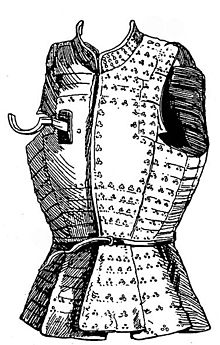
A brigandine is a form of body armour from the late Middle Ages and up to the early Modern Era. It is a garment typically made of heavy cloth, canvas, or leather, lined internally with small oblong steel plates riveted to the fabric, sometimes with a second layer of fabric on the inside.
Origins
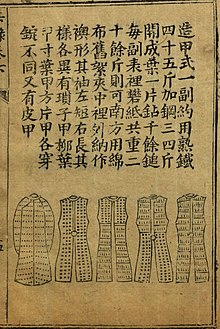
Protective clothing and armour have been used by armies from earliest recorded history; the King James Version of the Bible (Jeremiah 46:4) translates the Hebrew סריון, siryon or שריון, śiryon "coat of mail" as "brigandine". Medieval brigandines were essentially a refinement of the earlier coat of plates, which developed in the late 12th century, typically of simpler construction with larger metal plates. This new armour became very popular first in Eastern Europe, especially in Hungary, towards the end of the 13th century and was adopted in western Europe several decades later.
Early brigandines appeared towards the end of the 14th century, but survived beyond this transitional period between mail and plate, and came into even wider use in the 15th century, continuing into the 16th century. 15th-century brigandines are generally front-opening garments with the rivets arranged in triangular groups of three, while 16th-century brigandines generally have smaller plates with the rivets arranged in rows.
The brigandine is sometimes confused with the haubergeon, while the name is often confused with the brigantine, a swift small sea vessel.
Construction

The form of the brigandine is essentially the same as the civilian doublet, though it is commonly sleeveless. However, depictions of brigandines with sleeves are known. The small armour plates were sometimes riveted between two layers of stout cloth, or just to an outer layer. Unlike armour for the torso made from large plates, the brigandine was flexible, with a degree of movement between each of the overlapping plates. Many brigandines appear to have had larger, somewhat L-shaped plates over the central chest area. The rivets attaching the plates to the fabric were often decorated, being gilt, or of latten, and sometimes embossed with a design. The rivets were also often grouped to produce a repeating decorative pattern. In more expensive brigandines the outer layer of cloth was usually of velvet. The contrast between a richly dyed velvet cloth and gilded rivet heads must have been impressive and, unsurprisingly, such armour was popular with high-status individuals.
Modern flak jackets and ballistic vests are based on the same principle.
Use
| This section needs additional citations for verification. Please help improve this article by adding citations to reliable sources in this section. Unsourced material may be challenged and removed. (December 2010) (Learn how and when to remove this message) |
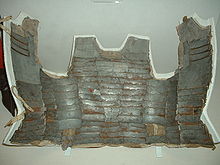
A brigandine was commonly worn over a gambeson and mail shirt and it was not long before this form of protection was commonly used by soldiers ranging in rank from archers to knights. It was most commonly used by men-at-arms. These wore brigandines, along with plate armour arm and leg protection, as well as a helmet. Even with the gambeson and the mail shirt, a wearer was not as well-protected as when wearing a complete harness of plate armour, but the brigandine was less expensive and also gave the soldier a greater degree of mobility and flexibility. A brigandine was also simple enough in design for a soldier to make and repair his own armour without needing the services of an armourer.
A common myth is that brigandines were so-named because they were a popular choice of protection for bandits and outlaws. This is untrue. Originally the term "brigand" referred to a foot soldier, and a brigandine was simply a type of armour worn by a foot soldier. It had nothing to do with its alleged ability to be concealed by bandits. In fact, brigandines were highly fashionable and were ostentatiously displayed by wealthy aristocrats both in European and in Asian courts.
Similar types
European jack of plate
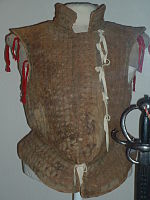
A similar type of armour was the jack of plate, commonly referred to simply as a "jack" (although this could also refer to any outer garment). This type of armour was used by common medieval European soldiers and the rebel peasants known as Jacquerie.

Like the brigandine, the jack was made of small iron plates between layers of felt and canvas. The main difference is in the method of construction: a brigandine uses rivets to secure the plates, whereas the plates in a jack are sewn in place. Jacks were often made from recycled pieces of older plate armour, including damaged brigandines and cuirasses cut into small squares.
Jacks remained in use as late as the 16th century and were often worn by Border reivers. Although they were obsolete by the time of the English Civil War many were taken to the New World by English settlers as they provided excellent protection from Native American arrows; one dating back to 1607 was found at Jamestown in 2008.
Indian "coat of ten thousand nails"
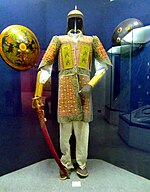
The medieval Indian equivalent of the brigandine was the chihal'ta hazar masha, or "coat of ten thousand nails", which was a padded leather jacket covered in velvet and containing steel plates which was used until the early 19th century. The skirt was split to the waist, allowing the soldier to ride a horse. Matching vambraces and boots containing metal plates were also used. It was derived from Islamic armour used by the Saracen armies. These were often elaborately decorated with gold lace, silk and satin and are highly prized by European collectors.
Tipu Sultan wore armour of this type during his wars against the East India Company. The Turks used similar armour during the Russo-Turkish Wars.
Two complete suits of armour are preserved in the Hermitage Museum, Saint Petersburg.
Chinese Bumianjia

A type of armour very similar in design to brigandine, known as cloth surface armor bumianjia (Chinese:布面甲; Pinyin: Bù miàn jiǎ), or nail (fastener, not finger or toe nail) armor dingjia (Chinese: 釘甲; Pinyin: Dīng jiǎ), was used in medieval China. It consisted of rectangular metal plates riveted between the fabric layers with the rivet heads visible on the outside. Sometimes optionally its chest was reinforced by a round mirror plate Chinese: 护心镜, hùxīnjìng, meaning "protect-heart mirror".
Russian orientalist and weapon expert Mikhail Gorelik states that it was invented in the 8th century as parade armour for the Emperor's guards by reinforcing a thick cloth robe with overlapping iron plates, but did not come into wide use until the 13th century, when it became widespread in the Mongol Empire under the name of hatangu degel ("robe which is as strong as iron"). He also argues that Eastern European kuyaks and, supposedly, Western European brigandines originate from this armour.
Bumianjia were still used in China as late as the Ming and Qing periods. It was favoured by common soldiers and officers alike for its rich, expensive look and protection. Later Qing examples, however, often lacked iron plates and were merely a military uniform.
Russian Kuyak


In Muscovy, there was a type of armour known as the kuyak, believed to have Mongolian origins and analogous to Central Asian, Indian and Chinese brigandines. The word "kuyak" is itself a derivative from the Mongol huyag, which means "armour" (of any type). No known intact examples of this type of armour survives, but historical depictions, textual descriptions and photos remain.
The descriptions, while not offering any in-depth details of the kuyak's construction, suggest a textile body armour reinforced with iron plates, usually not specifying directly their placement, only mentioning the "nails" (rivets) which attached the plates to the cloth. This was often worn with faulds, pauldrons and arm protection (rerebraces and vambraces), sometimes covered in expensive textiles like sateen, velvet or damask and decorated with fur.
Some kuyaks had large "mirror" plates or "shields" attached to the outside. Some descriptions also mention cotton wool padding.
There were also brigandine helmets called "kuyak hats" that used the same principle of construction as the kuyak body armour.
Serbian Toke
Clothes with sewn in pieces of metal, used by the Serbian revolutionaries in the uprising against the Ottoman rule (1804–1813, 1814, 1815–1817)
Toke were also worn decoratively, in which case were made of silver and gold.
One of the famous leaders of the rising Uzun Mirko Apostolović wears the Toke in his famous portrait by Uroš Knežević
Japanese Kikko Armour
Kikko is the Japanese form of brigandine. Kikko are hexagonal plates made from iron or hardened leather and sewn to cloth. These plates were either hidden by a layer of cloth or left exposed. Kikko were used only relatively recently, during the 16th century.
Kikko comes in many forms including coats, vests, gloves, arm and thigh protectors, and helmet neck guards. Kikko armour was worn as a standalone defense or under other types of armour as additional protection.
Korean Dujeong-gap (두정갑)
The Korean Dujeong-gap is the Korean equivalent of brigandine worn by the Joseon Army and Navy. In the late Joseon dynasty, the Dujeong-gap became the primary form of Korean metallic armor and often reached below the knees when worn. The helmet assumes a conical shape and has three brigandine neck defenses attached to the sides and back of the helmet. The exterior fabric of the Dujeong-gap varied; however, examples from the 18th century onwards show the usage of red cotton flannel, red velvet, and yellow cotton (often used for less decorated armors worn by lower-ranking officers and soldiers). The plates used within the Dujeong-gap also varied and could be made of either iron, copper, or leather. Dujeong-gaps with metal plates were worn by the Pengbaesu, and the Gabsa, while Dujeong-gaps with leather plates were part of a set of leather armor worn by peasants called pigabju.
-
 armor and helmet. Joseon period, 19th century. Musée Guimet.
armor and helmet. Joseon period, 19th century. Musée Guimet.
-
 Joseon conical helmet with tassel.
Joseon conical helmet with tassel.
-
 Yun Kwan, a General during the Goryeo dynasty, depicted as wearing a Dujeong-gap. Likely anachronistic.
Yun Kwan, a General during the Goryeo dynasty, depicted as wearing a Dujeong-gap. Likely anachronistic.
-
 Joseon dynasty Dujeong-gap showing internal plate layout,
Joseon dynasty Dujeong-gap showing internal plate layout,
-
 Modern reenactors wearing a complete Dujeong-gap set. While conventionally shown as red, the fabric is made of various colors.
Modern reenactors wearing a complete Dujeong-gap set. While conventionally shown as red, the fabric is made of various colors.
-
 leather plated Dujeong-gap (right) armor, a variant of a pigabju.
leather plated Dujeong-gap (right) armor, a variant of a pigabju.
-
 Joseon Armor sent to Austria-Hungary
Joseon Armor sent to Austria-Hungary
See also
References
- Compendious Hebrew-English Dictionary Avinoam and Segal, The Dvir Publishing Co, Tel-Aviv
- Strong's Exhaustive Concordance of the Bible, James Strong
- Kriskó Gyula. Az Árpád-kor háborúi. Bp. Zrínyi Katonai Kiadó 1986
- Cyclopædia, or, An universal dictionary of arts and sciences, Ephraim Chambers, 2 volumes, with the 1753 supplement, 2 volumes; digitized by the University of Wisconsin Digital Collections Center. p. 127
- Edge and Paddock. Arms and Armour of the Medieval Knight. Saturn Books, London, 1996.
- Barbara Tuchman. A Distant Mirror. Alfred A. Knopf, NY (1978). pp. 155ff.
- "Jack of plates: Evidence of recycling". Archived from the original on 24 December 2012. Retrieved 9 July 2009.
- Archaeologists uncover jack of plate at Jamestown Archived 11 May 2008 at the Wayback Machine
- H. Russell Robinson (2002). Oriental Armour. Courier Dover Publications. pp. 103–. ISBN 978-0-486-41818-6. Retrieved 20 February 2011.
- ^ Mikhail Gorelik. Armies of the Mongolo-Tatars, X–XIV centuries.
- William Alexander (1805). The costume of China, illustrated in forty-eight coloured engravings. Wikisource: W. Bulmer and Co. Retrieved 7 May 2014.
This dress of the troops is clumsy, inconvenient, and inimical to the performance of military exercises, yet a battalion thus equipped has, at some distance, a splendid and even warlike appearance; but on closer inspection these coats of mail are found to be nothing more than quilted nankeen, enriched with thin plates of metal, surrounded with studs, which gives the tout-ensemble very much the appearance of armour.
- See also a photo of the same set of armour (in the center). Dated late 15th century. The description: "5. A soft type of armour which bears the name of the kuyak, also with a kuyak helmet (15th century)".
- Fedor Solntsev's "Ancients of the Russian State" (1849–53) directly calls the kuyak a "Mongolian cotton fiber body armour".
- L. Bobrov and Y. Hudyakov in their "Late Medieval Central Asian Warrior's Protective Gear" directly refer to Central Asian brigandine armours as "kuyaks".
- Brockhaus and Efron Encyclopedic Dictionary states that the Chinese had armours almost indistinguishable from Russian kuyaks.
- Photo of a kuyak body armour and "hat" (in the center; pieces of a European fullplate armour are unrelated), dated late 15th century. The description: "5. A soft type of armour which bears the name of the kuyak, also with a kuyak helmet (15th century)".
- P.I. Savvaitov: Description of ancient Tsar's utensil, clothes, weapons, armours and trappings, extracted from manuscripts of the Archives of Moscow – Sanct-Petersburg, 1865; A.V. Viskovatov: Historical description of the clothes and weapons of Russian troops – 1841; Brockhaus and Efron Encyclopedic Dictionary; and others.
- Fedor Solntsev's "Ancients of the Russian State" (1849–53) contain descriptions of both kuyak body armours and kuyak helmets ("hats") padded with cotton wool and reinforced with small iron plates, which are fixed by small "nails" (rivets).
- Depiction and description of a kuyak hat from Fedor Solntsev's "Ancients of the Russian State" (1849–53).
- Anthony J. Bryant; Angus McBride (1989). The samurai: warriors of medieval Japan, 940–1600. Osprey Publishing. pp. 53–. ISBN 978-0-85045-897-8. Retrieved 20 February 2011.
- ^ George Cameron Stone (1999). A Glossary of the Construction, Decoration and Use of Arms and armour: In All Countries and in All Times. Courier Dover Publications. pp. 246–. ISBN 978-0-486-40726-5. Retrieved 20 February 2011.
- Japanese arms & armour. Crown Publishers. 1969. Retrieved 20 February 2011.
- "Home>전시안내>특별전시|국립고궁박물관". www.gogung.go.kr. Archived from the original on 12 December 2015. Retrieved 2 September 2021.
External links
- Hans Memling triptych wing depicting brigandine, c 1470
- Oriental Brigandines at The Silk Road Designs Armoury (same site at the internet archive)
- Rajput armour
| Components of medieval European armour | ||
|---|---|---|
| Head |  | |
| Face | ||
| Neck | ||
| Torso | ||
| Arms | ||
| Legs | ||
| Pieces | ||